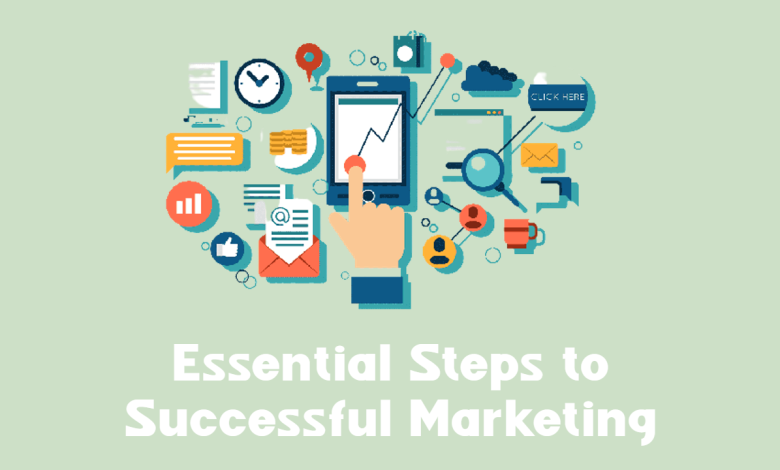6 Essential Steps to Successful Marketing

Marketing is one of the scary parts for many new brands and small companies. There are too many factors, variables, and options to consider. And for some, it might seem like a guessing game. Yet, even if you are a student entrepreneur with no experience in this field, it is possible to win this game.
Long gone are the days when marketing was about assumptions. Any successful strategy should be based on research. Fortunately, all of it can be done online. All one needs is a decent amount of time. If you are a student, that can be a problem. Time is one thing that students do not have as they are always overloaded with all types of things. Starting from lectures and seminars and up to endless writing assignments. Sometimes it might be impossible to finish an essay, not to mention devote an evening to research marketing tactics. But there is a solution to that, a professional academic paper writer from WritePaper.com is always happy to help with any type of college assignment. Whether you struggle with an essay, research paper, case study, or term paper – they can help you out. It is an easy and efficient way to get more free time and excellent grades. At the same time, this guide will assist with actionable steps on how to build a marketing strategy for your business.

Set Mission and Goals
The foundation of any effective marketing strategy is the business’ mission and goals. A mission statement is the basis of every move you will be taking in the future. It should cover why the company exists and what its purpose is. Also, it needs to address how it is beneficial for customers.
Goals have to do with the results you expect from the campaign and strategy altogether. They also need to be formulated with the idea of the customer cycle in mind. Goals need to be SMART, meaning
- Specific;
- Measurable;
- Achievable;
- Relevant;
- Time-bound.
The goals can be anything like increasing sales, building brand awareness, attracting more followers, increasing subscriptions or conversion, growth in customers, etc. Write them down as they will shape future campaigns and tactics.
An important thing to remember – one campaign or tactic won’t solve all the issues. Usually, each one is designed to achieve one or two of them at a time. That’s why businesses use several tactics or campaigns at a time.
Define the Audience
You probably have a good idea of your target audience based on the product and mission statement. But try to get as many details as possible based on research and numbers. You can look into the markets available, niches, or website visitors’ demographics. Identify
- What is your audience’s income or price range?
- What are the basic demographics (age, location, gender, marital status, race, education);
- What problems can be solved with your product?
- What are the main marketing channels for these demographics?
Decide on Marketing Tactics
Now you have all the essential data, it is time to research and define future tactics. This means planning the actual things you need to do to achieve set goals. These can be running a social media campaign, investing in paid promotion, or starting with search engine optimization.
One can start by researching the competitors and their tactics as well as the industry’s best practices. Look at what works best and aim for that.
Figure out the main channels of communication with the audience:
- Blog;
- Website;
- Social media;
- Email marketing;
- Traditional channels (billboards, newspapers, radio);
- Advertising online (PPC), etc.
Although companies put more stress on their online marketing strategies, offline or traditional marketing should not be underestimated, as it might be more effective for some businesses. With the recent evolution of outdoor marketing companies come with creative and innovative approaches like advertising with digital displays, 3D printings in targeted locations, and customizable inflatables. The latter is a dynamic, eye-catching alternative to traditional forms of advertising that allow businesses to easily draw attention to their products or services. Inflatables for advertising can also make it easier to build brand recognition as customers associate the unique look and feel of an inflatable with a specific product or company.
Different channels need different types of content. Alternatively, it can be similar content but adjusted for a particular tactic.
Choose the specific tactics and channels based on your mission, product, price, and audience. Also, consider the resources you can invest in it. Some campaigns can be much cheaper than others.

Create Plan and Budget
Budget is a cornerstone of all marketing efforts a business can do. Paid advertising is not always available for small brands. But search engine optimization can bring much better results and attract free organic traffic to the website.
At this stage, one needs to sit down and write a year plan for marketing. It needs to have all the deadlines, important dates (holidays usually mean increased promotion and special deals), tactics, goals, and result metrics.
In terms of budget, it has to include a breakdown of costs for every campaign. Remember that the fact that it is a plan for a year doesn’t mean that it cannot change. It is crucial to update and adjust it based on the company’s growth and new goals as well as real-life events.
Get it Going
Now it is time to execute all that was planned. Get into creating content, optimizing a website, or crafting special offers.
Evaluate Results
This one will be a constant thing. One needs to always control, evaluate, analyze, and repeat or adjust tactics. For example, if something isn’t performing as planned, it needs to be modified. Or, if a specific tactic proved to be effective, repeat it.
It is crucial to have measurable results to eliminate any guessing from your strategy. Those can be:
- Number of sales;
- Number of visitors;
- Increased/decreased conversions;
- Number of people subscribed after the campaign;
- Number of views and actions on social media posts;
- Retention statistics and customers coming back;
- Website SEO performance;
- Bounce-back numbers, etc.
These measurables are a direct reflection of the goals set previously. If the main objective of a campaign was to attract more organic traffic through blogging, the main measurable would be the number of visitors.
In Summary
Marketing might seem scary and complicated. And it is difficult, of course, but manageable. With the right amount of research and planning, it is much easier to develop a winning strategy. Remember that all the tactics you implement need to align with the mission statement and goals. Design campaigns with customers in mind. Gather results, evaluate and analyze them to see what works best for your brand. And repeat the winning tactics.




